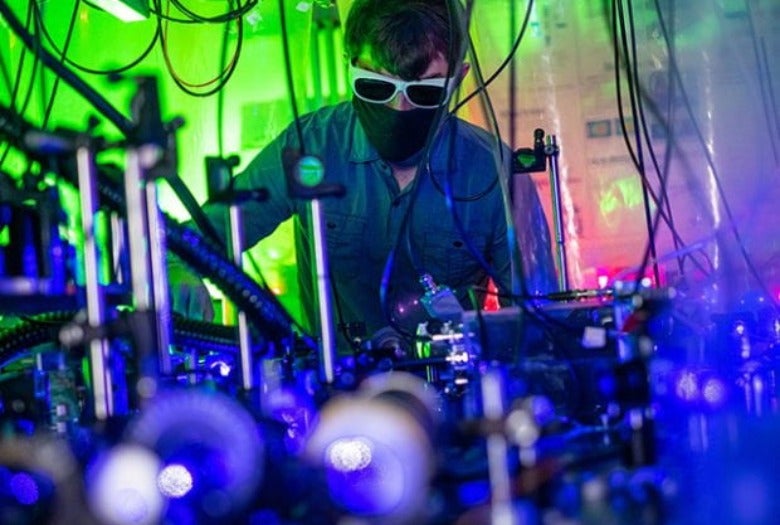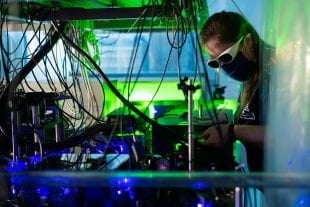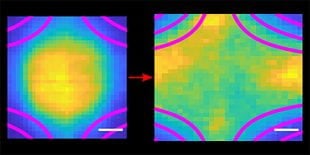HOUSTON – (March 1, 2021) – Rice University physicists have discovered a way to trap the world's coldest plasma in a magnetic bottle, a technological achievement that could advance research into clean energy, space weather and astrophysics.
"To understand how the solar wind interacts with the Earth, or to generate clean energy from nuclear fusion, one has to understand how plasma — a soup of electrons and ions — behaves in a magnetic field," said Rice Dean of Natural Sciences Tom Killian, the corresponding author of a published study about the work in Physical Review Letters.
https://youtu.be/97DMTPmvMiI
Using laser-cooled strontium, Killian and graduate students Grant Gorman and MacKenzie Warrens made a plasma about 1 degree above absolute zero, or approximately -272 degrees Celsius, and trapped it briefly with forces from surrounding magnets. It is the first time an ultracold plasma has been magnetically confined, and Killian, who's studied ultracold plasmas for more than two decades, said it opens the door for studying plasmas in many settings.
"This provides a clean and controllable testbed for studying neutral plasmas in far more complex locations, like the sun's atmosphere or white dwarf stars," said Killian, a professor of physics and astronomy. "It's really helpful to have the plasma so cold and to have these very clean laboratory systems. Starting off with a simple, small, well-controlled, well-understood system allows you to strip away some of the clutter and really isolate the phenomenon you want to see."
That's important for study co-author Stephen Bradshaw, a Rice astrophysicist who specializes in studying plasma phenomena on the sun.
"Throughout the sun's atomosphere, the (strong) magnetic field has the effect of altering everything relative to what you would expect without a magnetic field, but in very subtle and complicated ways that can really trip you up if you don't have a really good understanding of it," said Bradshaw, an associate professor of physics and astronomy.
Solar physicists rarely get a clear observation of specific features in the sun's atmosphere because part of the atmosphere lies between the camera and those features, and unrelated phenomena in the intervening atmosphere obscures what they'd like to observe.
"Unfortunately, because of this line-of-sight problem, observational measurements of plasma properties are associated with quite a lot of uncertainty," Bradshaw said. "But as we improve our understanding of the phenomena, and crucially, use the laboratory results to test and calibrate our numerical models, then hopefully we can reduce the uncertainty in these measurements."
Plasma is one of four fundamental states of matter, but unlike solids, liquids and gases, plasmas aren't generally part of everyday life because they tend to occur in very hot places like the sun, a lightning bolt or candle flame. Like those hot plasmas, Killian's plasmas are soups of electrons and ions, but they're made cold by laser-cooling, a technique developed a quarter century ago to trap and slow matter with light.
Killian said the quadrupole magnetic setup that was used to trap the plasma is a standard part of the ultracold setup that his lab and others use to make ultracold plasmas. But finding out how to trap plasma with the magnets was a thorny problem because the magnetic field plays havoc with the optical system that physicists use to look at ultracold plasmas.
"Our diagnostic is laser-induced fluorescence, where we shine a laser beam onto the ions in our plasma, and if the frequency of the beam is just right, the ions will scatter photons very effectively," he said. "You can take a picture of them and see where the ions are, and you can even measure their velocity by looking at the Doppler shift, just like using a radar gun to see how fast a car is moving. But the magnetic fields actually shift around the resonant frequencies, and we have to disentangle the shifts in the spectrum that are coming from the magnetic field from the Doppler shifts we're interested in observing."
That complicates experiments significantly, and to make matters even more complicated, the magnetic fields change dramatically throughout the plasma.
"So we have to deal with not just a magnetic field, but a magnetic field that's varying in space, in a reasonably complicated way, in order to understand the data and figure out what's happening in the plasma," Killian said. "We spent a year just trying to figure out what we were seeing once we got the data."
The plasma behavior in the experiments is also made more complex by the magnetic field. Which is precisely why the trapping technique could be so useful.
"There is a lot of complexity as our plasma expands across these field lines and starts to feel the forces and get trapped," Killian said. "This is a really common phenomenon, but it's very complicated and something we really need to understand."
One example from nature is the solar wind, streams of high-energy plasma from the sun that cause the aurora borealis, or northern lights. When plasma from the solar wind strikes Earth, it interacts with our planet's magnetic field, and the details of those interactions are still unclear. Another example is fusion energy research, where physicists and engineers hope to recreate the conditions inside the sun to create a vast supply of clean energy.
Killian said the quadrupole magnetic setup that he, Gorman and Warrens used to bottle their ultracold plasmas is similar to designs that fusion energy researchers developed in the 1960s. The plasma for fusion needs to be about 150 million degrees Celsius, and magnetically containing it is a challenge, Bradshaw said, in part because of unanswered questions about how the plasma and magnetic fields interact and influence one another.
"One of the major problems is keeping the magnetic field stable enough for long enough to actually contain the reaction," Bradshaw said. "As soon as there's a small sort of perturbation in the magnetic field, it grows and 'pfft,' the nuclear reaction is ruined.
"For it to work well, you have to keep things really, really stable," he said. "And there again, looking at things in a really nice, pristine laboratory plasma could help us better understand how particles interact with the field."
The research was supported by the Air Force Office of Scientific Research (FA9550-17-1-0391) and the National Science Foundation Graduate Research Fellowship Program (1842494).
-30-
Links and resources:
The DOI of the Physical Review Letters paper is: 10.1103/PhysRevLett.126.085002
A copy of the paper is available at: https://doi.org/10.1103/PhysRevLett.126.085002
VIDEO is available at:
High-resolution IMAGES are available for download at:
https://news-network.rice.edu/news/files/2021/02/0301-BOTTLE-fields-lg.jpg
CAPTION: Images produced by laser-induced fluorescence show how a rapidly expanding cloud of ultracold plasma (yellow and gold) behaves when confined by a quadrupole magnet. Ultracold plasmas are created in the center of the chamber (left) and expand rapidly, typically dissipating in a few thousandths of a second. Using strong magnetic fields (pink), Rice University physicists trapped and held ultracold plasmas for several hundredths of a second. By studying how plasmas interact with strong magnetic fields in such experiments, researchers hope to answer research questions related to clean fusion energy, solar physics, space weather and more. (Image courtesy of T. Killian/Rice University)
https://news-network.rice.edu/news/files/2021/02/0301-BOTTLE-gg99-lg.jpg
CAPTION: Rice University graduate student Grant Gorman at work in Rice's Ultracold Atoms and Plasmas Lab. (Photo by Jeff Fitlow/Rice University)
https://news-network.rice.edu/news/files/2021/02/0301-BOTTLE-grp25-lg.jpg
CAPTION: Rice University physicists (from left) Grant Gorman, Tom Killian and MacKenzie Warrens discovered how to trap the world's coldest plasma in a magnetic bottle, a technological achievement that could advance research into clean energy, space weather and solar physics. (Photo by Jeff Fitlow/Rice University)
https://news-network.rice.edu/news/files/2021/02/0301-BOTTLE-mw78-lg.jpg
CAPTION: Rice University graduate student MacKenzie Warrens adjusts a laser-cooling experiment in Rice's Ultracold Atoms and Plasmas Lab. (Photo by Jeff Fitlow/Rice University)
https://news-network.rice.edu/news/files/2021/02/0301-BOTTLE-sb-lg.jpg
CAPTION: Rice University plasma physicist Stephen Bradshaw studies solar flares, heating in the sun's atmosphere, solar wind and other solar physics phenomena. (Photo by Jeff Fitlow/Rice University)
This release can be found online at news.rice.edu.
Follow Rice News and Media Relations via Twitter @RiceUNews.
Located on a 300-acre forested campus in Houston, Rice University is consistently ranked among the nation’s top 20 universities by U.S. News & World Report. Rice has highly respected schools of Architecture, Business, Continuing Studies, Engineering, Humanities, Music, Natural Sciences and Social Sciences and is home to the Baker Institute for Public Policy. With 3,978 undergraduates and 3,192 graduate students, Rice’s undergraduate student-to-faculty ratio is just under 6-to-1. Its residential college system builds close-knit communities and lifelong friendships, just one reason why Rice is ranked No. 1 for lots of race/class interaction and No. 1 for quality of life by the Princeton Review. Rice is also rated as a best value among private universities by Kiplinger’s Personal Finance.





